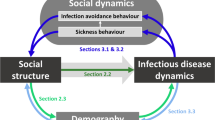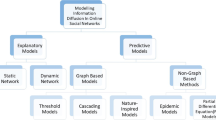Abstract
Will the practice of collecting wild honey wearing no clothes become a widespread practice in Zimbabwe? Or will beekeeping take over as the main way that people acquire honey? Both practices impact on forest resources; how can the foresters influence the uptake of these ideas? This paper describes an exploratory modelling study investigating how social network patterns affect the way ideas spread around communities. It concludes that increasing the density of social networks increases the spread of successful ideas whilst speeding the loss of ideas with no competitive advantage. Some different kinds of competitive advantage are explored in the context of forest management and rural extension.
Similar content being viewed by others
References
Arnon, I. (1989),Agricultural Research and Technological Transfer, Elsevier Applied Science, New York.
AtKisson, A. (1991), ‘The innovation diffusion game: A tool for encouraging participation in positive cultural change — or for doing something different at your next party’,In Context, 28: 58, http://www.context.org/ICLIB/IC28/AtKisson.htm, accessed 3 February 2003.
Axelrod, R. (1997),The Complexity of Cooperation: Agent-Based Models of Competition and Collaboration, Princeton University Press, Princeton.
Axelrod, R. and Cohen, M. D. (1999),Harnessing Complexity: Organizational Implications of a Scientific Frontier, The Free Press, New York.
Blackmore, S. (1999),The Meme Machine, Oxford University Press, Oxford.
Clarke, R. (1999), ‘A primer in diffusion of innovations theory’, Xamax Consultancy Pty Ltd, Canberra, http://www.anu.edu.au/people/Roger.Clarke/SOS/InnDiff.html, accessed 5 February 2003.
Dawkins, R. (1976),The Selfish Gene. Oxford University Press, Oxford.
Dennett, D. (1995),Darwin’s Dangerous Idea, Penguin Books, London.
Epstein, J.M. and Axtell, R. (1996),Growing Artificial Societies — Social Science from the Bottom Up, MIT Press, Cambridge.
Ferber, J., (1998),Multi-Agent Systems, Addison-Wesley, Reading.
Gladwell, M. (2000),The Tipping Point: How Little Things Can Make a Big Difference, Abacus, London.
Haggith, M. and Prabhu, R. (2003), ‘Unlocking complexity: The importance of idealisation in simulation modelling’,Small-scale Forest Economics, Management and Policy, 2(2): 293–312.
Lynch, A. (1996),Thought Contagion: How Belief Spreads Through Society, Basic Books, New York.
Rogers, E.M. (1995),Diffusion of Innovations, The Free Press, New York.
Simon, H.A. (1960),The New Science of Management Decisions, Harper & Row, New York.
Standa-Gunda, W. and Prabhu, R. (2001), ‘Spatial lags hypothesis: Discerning conceptual frameworks for communication networks’, Unpublished paper, CIFOR, Harare.
Thomson, A., Haggith, M. and Prabhu, R.(2003), ‘Innovation diffusion: Modelling the rate of adoption of new technologies and policies’,Journal of Technological forecasting and social change, in process.
Vanclay, J.K. (1998), ‘FLORES: For exploring land-use options in forested landscapes’,Agroforestry Forum, 9(1): 47–52.
Vanclay, J.K. (2003), ‘Why model landscapes at the level of households and fields?’,Small-scale Forest Economics, Management and Policy, 2(2): 121–134.
Author information
Authors and Affiliations
Additional information
The authors are grateful to the UK’s Department for International Development (DFID) and the European Community for financial support of this project.
Rights and permissions
About this article
Cite this article
Haggith, M., Prabhu, R., Colfer, C.J.P. et al. Infectious ideas: Modelling the diffusion of ideas across social networks. Small-scale Forestry 2, 225–239 (2003). https://doi.org/10.1007/s11842-003-0017-3
Issue Date:
DOI: https://doi.org/10.1007/s11842-003-0017-3




